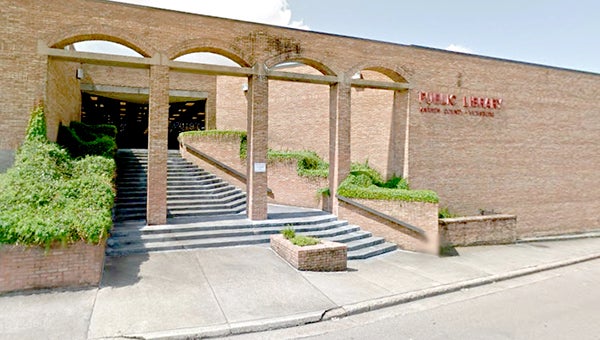ON THE SHELF: This week we are delving into the Civil Rights Era with these Adult Nonfiction selections
Published 3:59 pm Saturday, January 13, 2024

- Pictured is the Warren County-Vicksburg Public Library. (File photo/The Vicksburg Post)
This column was submitted by Evangeline Cessna, Local History Librarian at the Warren County-Vicksburg Public Library.
This week’s column features new titles in the Adult Nonfiction collection.
“This Light of Ours: Activist Photographers of the Civil Rights Movement,” by Leslie G. Kelen presents the struggle for equal rights through the work of nine activist photographers—both men and women. Unlike the images produced by photojournalists who documented breaking news events, these photographers lived within the movement—primarily within the Student Nonviolent Coordinating Committee. The core of this book contains a selection of 150 black and white photographs representing the work of photographers Bob Adelman, George Ballis, Bob Fitch, Bob Fletcher, Matt Herron, David Prince, Herbert Randall, Maria Varela and Tamio Wakayama. The images are grouped around four movement themes—SNCC’s organizing strategies, resolve in the face of violence, impact on local and national politics and influence on the nation’s changing consciousness. These photographs remind us that the Civil Rights Movement was fought by thousands of “ordinary” Americans, especially the nation’s courageous youth.
“The Struggle of Struggles (Civil Rights in Mississippi Series),” by Vera Pigee describes how the author put her life and livelihood on the line with her grassroots effort for social change in Mississippi from 1955 to 1975. Known as the “Lady of Hats,” Pigee was a businesswoman, mother and leader in the NAACP. This book is a detailed look at the daily grind of organizing for years against the state’s closed-minded lawmakers. She not only battled white supremacists but also those who were unwilling to accept the leadership of a strong woman. Women like her often worked without recognition in their communities all over the country but did not document their work like Pigee did. Originally published in 1975, this autobiography highlights the gender and generational tensions within the civil rights movement. It also outlines the complexity, frustration and snubs of the work as well as the joys and triumphs. Pigee’s experiences and observations were key in the quest for a fairer and more just society.
“Three Years in Mississippi,” by James Meredith is from the Civil Rights in Mississippi Series. On Oct. 1, 1962, James Meredith became the first African American student to enroll at the University of Mississippi. His admission was preceded by violent rioting which resulted in two deaths and a lengthy court battle that made it to the Supreme Court, but it became a pivotal moment in the civil rights movement. Meredith risked everything to attend Ole Miss because he felt a “divine responsibility” to end white supremacy. He describes the intense struggle to attend the all-white university and break-down the long-held race barrier in Mississippi. First published in 1966, more than ten years after Brown v. Board of Education, this book offers a glimpse of a crucial point in history and the determination and courage of a single man against insurmountable odds.
Mathew Callahan tells the story of the songs and music that enslaved people have used to uplift themselves, their rebellions and their escapes in his book, “Songs of Slavery and Emancipation.” Many people misunderstand the slave songs and spirituals of history. They were not only lamentations of suffering or distractions from a life of misery, but they also openly called for liberty and revolution while celebrating heroes like Gabriel Prosser, Nat Turner and the rebels of the Haitian Revolution. The fight for freedom also included fugitive slaves, free people of color and their white allies who inspired a set of songs that were the songs of the abolitionists—and now largely forgotten. These songs were composed and disseminated until the Civil War and some were even published by abolitionists to be used at public meetings. Mat Callahan highlights some of these songs which challenge common misconceptions of abolitionism. These songs not only express outrage at slavery but call for militant resistance to destroy the slave system, the emancipation of Americans of African descent and a clear demand for equality and justice for all humanity.
Mark Newman won the 2020 American Studies Network Book Prize for his work, “Desegregating Dixie: The Catholic Church in the South and Desegregation, 1945-1992.” Drawing on a plethora of archives and interviews, Newman reveals the complex response of the African American and white Catholic response to desegregation in the South. The southern Catholic Church contributed to segregation in the first half of the twentieth century by confining African Americans to the back of white churches and to black-only schools and churches. Papal adoption and dissemination of the doctrine of the Mystical Body of Christ along with pressure from both black and white Catholics and secular changes brought about by the civil rights movement led the Church to address racial discrimination both inside and outside of their congregations. It wasn’t unanimous, though, white Catholics in the South split between a moderate segregationist majority and the minorities of the hard-line segregationists and progressive racial egalitarians. Some bishops on the periphery in the South began desegregation before or in the anticipation of secular changes. Desegregation shook congregations, but seldom brought about genuine integration.





